What You’ll Learn in the Ultimate Guide to Gliders
- What is a Glider?: The basic definition and types of gliders.
- How Do Gliders Stay in the Air?: The science of glider flight.
- Forces Acting on a Glider: The key forces that keep a glider airborne.
- Glide Ratio: How far can a glider go?
- Types of Gliders: The many shapes and sizes of gliders.
- What’s it Like to Fly a Glider?: The experience of glider flight.
- History of Gliders: From the Wright brothers to World War II and beyond.
- Becoming a Glider Pilot: What you need to know and do.
- Safety Considerations: How to glide safely.
- Famous Glider Flights: Record-breaking and historic glider flights.
What is a Glider? An In-Depth Look
Definition
A glider is a fixed-wing aircraft that relies on the dynamic reaction of air against its lifting surfaces for flight. Unlike most aircraft, the majority of gliders do not have an engine.
Motor-Gliders
However, there are exceptions known as motor gliders. These have small engines that can extend their flight when necessary.
The Basic Definition
A glider is a unique type of fixed-wing aircraft that distinguishes itself from other flying machines through its reliance on the dynamic reaction of air against its lifting surfaces. In simpler terms, a glider is designed to float on air currents, much like a sailboat sails on water. Unlike conventional airplanes, most gliders do not have an engine, making them the epitome of engine-less flight.
The Anatomy of a Glider
Wings
The wings are the most crucial part of a glider, designed to maximize lift while minimizing drag. They are usually long and thin to allow for better lift-to-drag ratios.
Fuselage
The fuselage houses the cockpit where the pilot sits and controls the glider. It is streamlined to reduce drag.
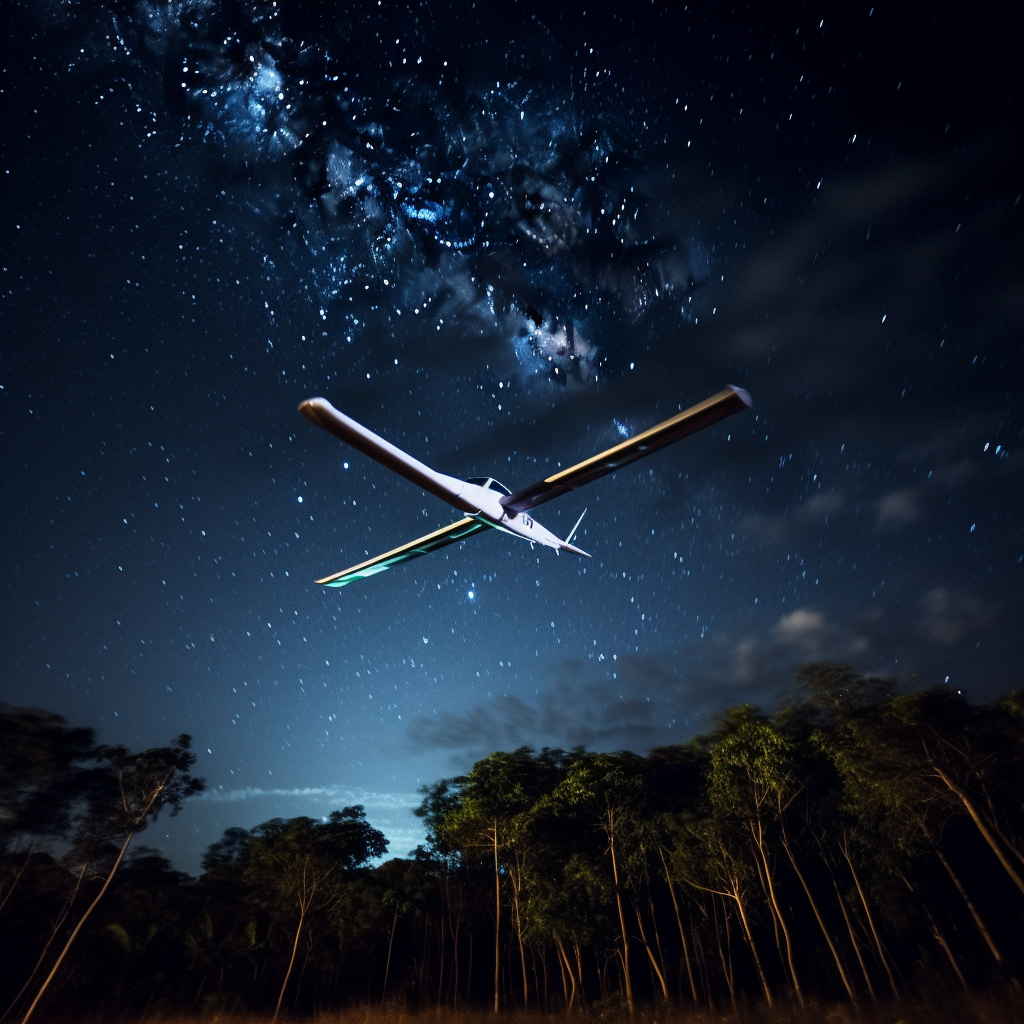
Tail
The tail stabilizes the glider and helps in steering. It usually consists of a vertical stabilizer and a horizontal stabilizer.
Landing Gear
Most gliders have retractable landing gear to reduce drag during flight. Some simpler models may have fixed landing gear.
Types of Gliders
Traditional Gliders
These are the most common types of gliders and are often used for sport and recreation. They are optimized for extended flights and can even perform aerobatics.
Motor-Gliders
Motor-gliders come equipped with small engines that can be used for taking off or extending the duration of a flight. They offer the best of both worlds: the ability to soar on air currents and the security of an engine if needed.
Hang Gliders
Hang gliders are foot-launched gliders where the pilot is usually in a prone position. They are more maneuverable but have a lower glide ratio compared to traditional gliders.
Paragliders
Paragliders are similar to hang gliders but use a soft wing structure. They are easy to transport and are often used for mountain flying.
Special-Purpose Gliders
These are designed for specific tasks like research, high-altitude flying, or even military applications. They are not commonly seen but serve important roles.
The Essence of Gliding
At its core, gliding is about harmony with nature. It’s about understanding the air currents, the weather, and the aerodynamics of flight, and using that knowledge to soar like a bird, free from the constraints of an engine. Whether you’re an aviation enthusiast, an aspiring pilot, or someone who just loves the idea of floating on air, gliders offer a unique and unforgettable experience.
By understanding what a glider is and the different types available, you’re taking the first step into a larger world—a world that offers the purest form of flight, unencumbered by the noise and complexity of engine-powered aviation.
How Do Gliders Stay in the Air? The Science of Soaring
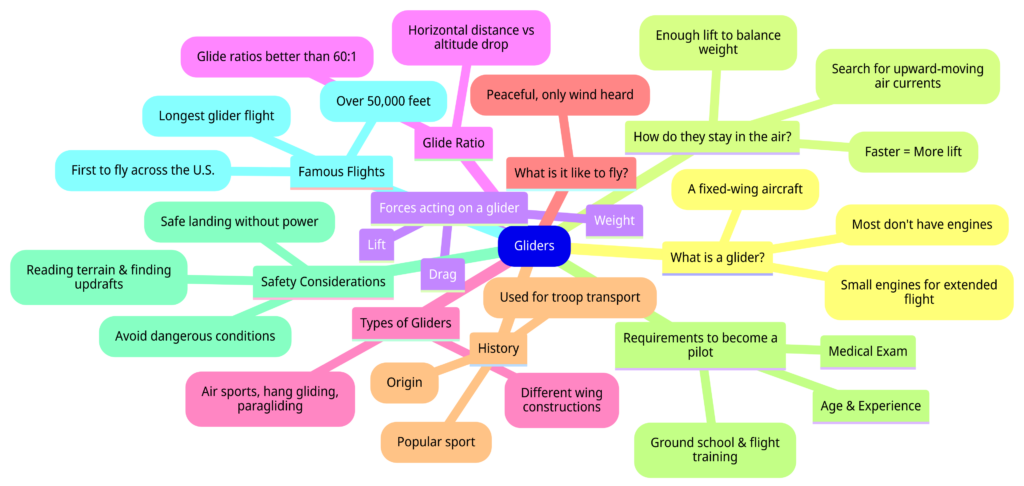
The Role of Lift
The wings of a glider must produce enough lift to balance the weight of the aircraft.
Speed and Lift
The faster the glider flies, the more lift its wings generate.
Updrafts
Glider pilots often search for upward-moving air currents, known as updrafts, to push the glider higher into the sky.
The Fundamental Principle: Lift vs. Weight
The most basic question about gliders is how they manage to stay airborne without an engine. The answer lies in the concept of lift. For a glider to stay in the air, the lift generated by its wings must equal or exceed the weight of the glider. This balance is crucial for maintaining altitude and is influenced by several factors.
Lift Equation
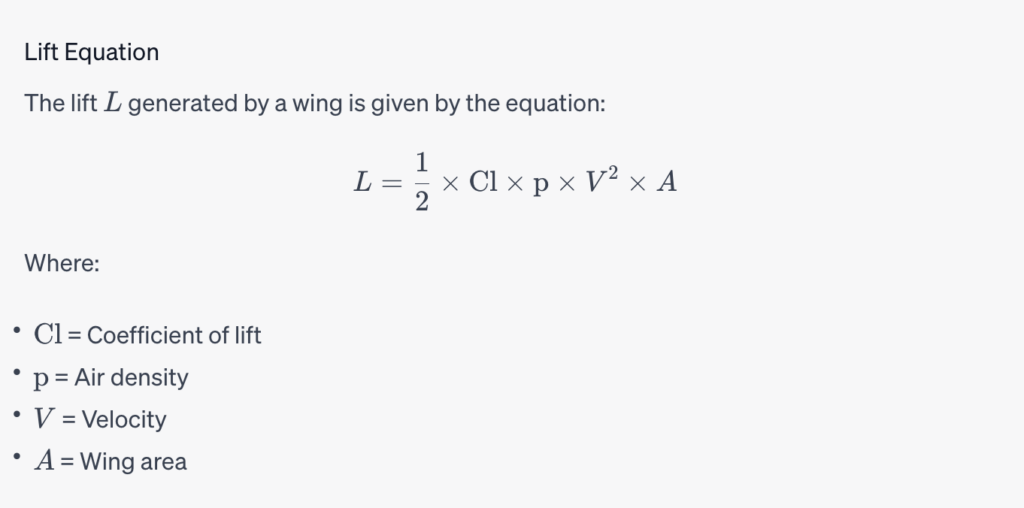
The Role of Speed
The speed at which a glider flies directly impacts the amount of lift its wings can generate. Faster speeds result in more lift, but there’s a trade-off: increased speed also means increased drag, which slows the glider down. Therefore, finding the optimal speed is crucial for efficient gliding.
Updrafts: The Invisible Elevators
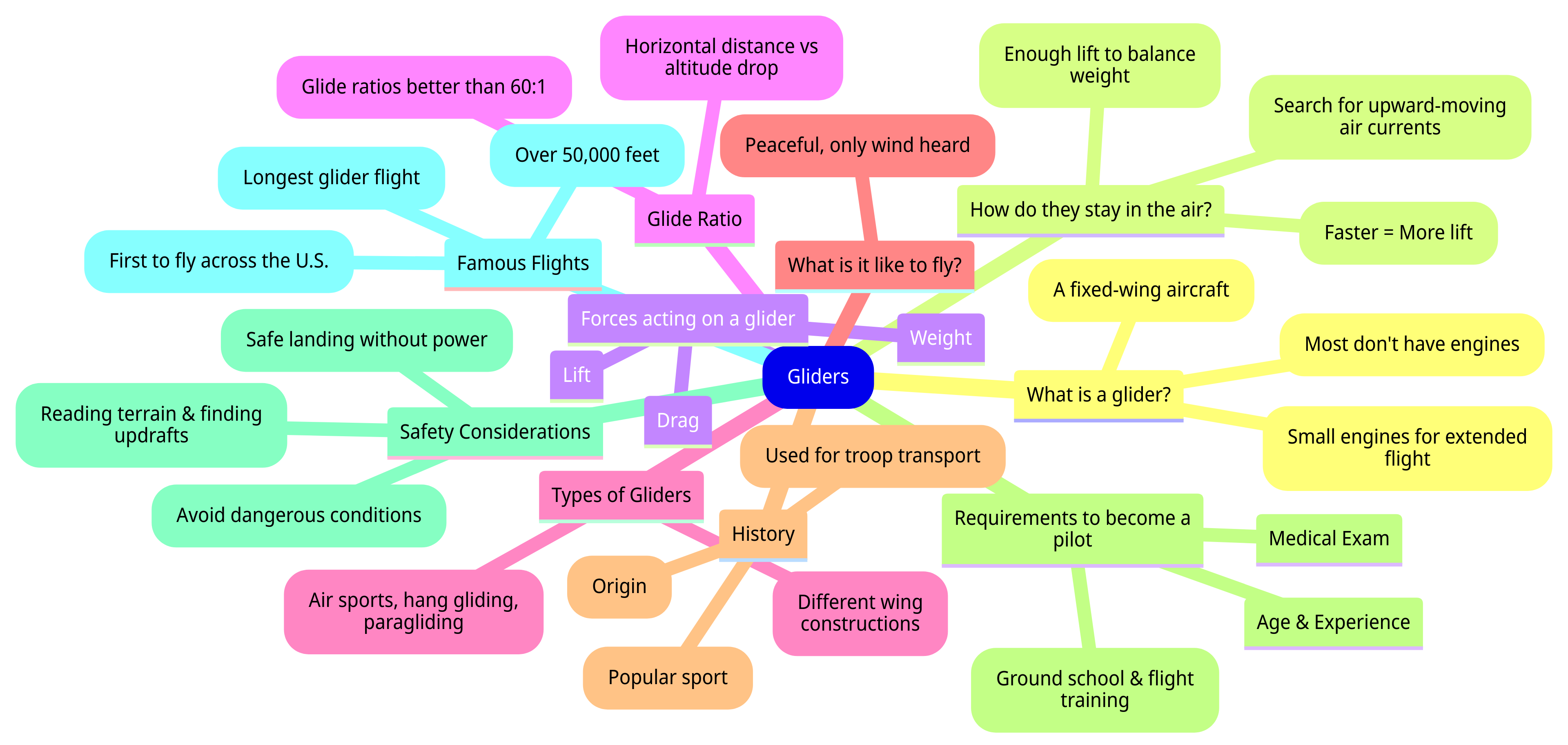
One of the most skillful aspects of gliding is the ability to find and utilize updrafts. These are columns or pockets of rising air that can give the glider a much-needed altitude boost. There are several types of updrafts:
Thermal Updrafts
Caused by the sun heating the ground, which in turn heats the air above it. The warm air rises in columns and can be used by gliders to gain altitude.

Orographic Lift
Occurs when wind hits a mountain, hill, or ridge, forcing the air to rise. Gliders can ride this rising air to higher altitudes.
Wave Lift
Similar to orographic lift but occurs at higher altitudes. It’s caused by air flowing over mountain ranges and can extend for hundreds of miles.
Convergence Zones
These are areas where different air masses meet and are forced upwards. They can provide strong and extensive lift.
Energy Management
Since a glider doesn’t have an engine to produce thrust, it has to manage its potential and kinetic energy carefully. Potential energy is gained through altitude, and kinetic energy is gained through speed. A good glider pilot knows how to convert between these two forms of energy efficiently to extend the duration and distance of their flight.
The Art of Gliding
Understanding how gliders stay in the air is not just about physics and equations; it’s also an art. Pilots must develop an intuitive sense for the air around them, much like sailors must understand the sea. They must read the sky, understand the terrain, and feel the subtle shifts in air currents to make the most of their engine-less journey through the skies.
By mastering the science and art of gliding, pilots can achieve incredibly long and fulfilling flights, touching the very essence of what it means to fly.
Forces Acting on a Glider: The Dynamics of Engineless Flight
The Big Three
- Lift: Counteracts the weight and keeps the glider in the air.
- Drag: Resists the motion of the glider.
- Weight: The force of gravity pulling the glider downward.
The Big Three: Lift, Drag, and Weight
Unlike powered aircraft, which have to contend with thrust and other forces, a glider primarily deals with three main forces: lift, drag, and weight. Understanding these forces is crucial for both novice and experienced glider pilots.
Lift
Lift is the force that allows a glider to rise and stay in the air. It counteracts the weight of the glider and is generated by the wings. The amount of lift can be influenced by several factors, including the speed of the glider, the angle of attack of the wings, and the air density.
Factors Affecting Lift
- Speed: Faster speeds generally produce more lift.
- Angle of Attack: The angle between the wing’s chord line and the oncoming air.
- Air Density: Higher density means more lift, which is why gliders often perform better in cooler temperatures.
Drag
Drag is the aerodynamic resistance that acts opposite to the relative motion of the glider. It’s essentially the force that tries to slow the glider down. Minimizing drag is crucial for maximizing the performance of a glider.
Types of Drag
- Parasitic Drag: Caused by any aircraft component that does not contribute to lift. Examples include the fuselage, tail, and landing gear.
- Induced Drag: Generated by the wing as it produces lift. It’s a byproduct of lift and decreases as the glider gains speed.
Weight
Weight is the force exerted on the glider due to gravity. It acts vertically downward towards the center of the Earth. The weight of a glider includes the aircraft itself, the pilot, and any additional equipment or ballast.
Balancing the Forces
For a glider to maintain straight and level flight, these forces must be in equilibrium:
- Lift must equal weight to maintain altitude.
- Drag must be overcome by converting potential energy (altitude) into kinetic energy (speed).
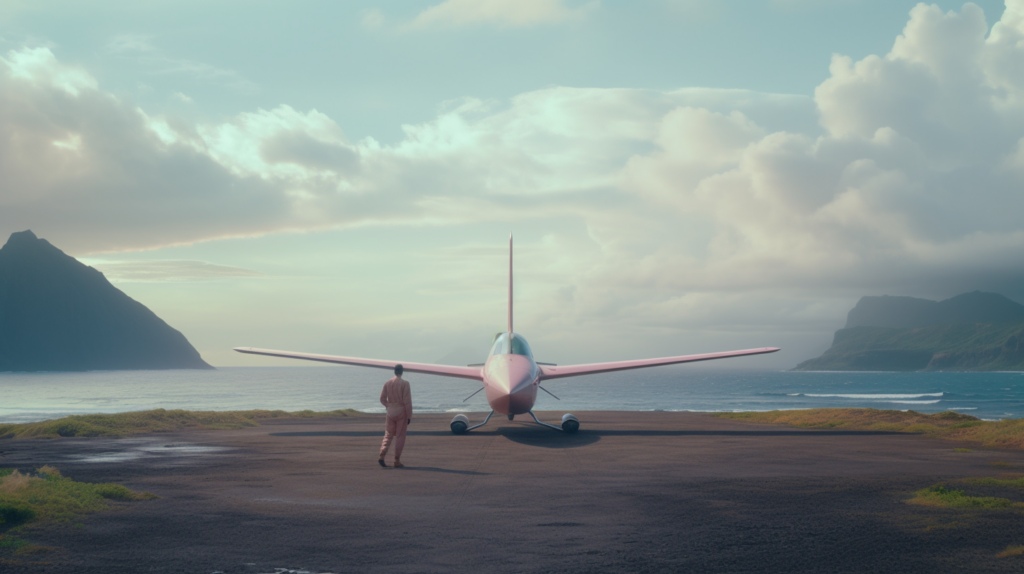
Maneuvering and Forces
When a glider turns, additional forces come into play:
- Centripetal Force: Needed to keep the glider turning. It’s provided by increasing the lift.
- Load Factor: The effective increase in the weight of the glider during a turn, often referred to as “G-forces.
The Role of the Pilot
The pilot’s role is to manage these forces effectively to achieve the desired flight path. This involves:
- Adjusting the angle of attack to control lift.
- Using the glider’s controls to minimize drag.
- Skillfully finding updrafts to counteract the weight and gain altitude.

The Beauty of Simplicity
One of the most appealing aspects of gliding is its simplicity. With only three main forces to consider, gliding offers a pure, uncluttered form of flight that brings pilots closer to the fundamental principles of aerodynamics. It’s a dance with the air, a test of skill and understanding, and a chance to experience flight in its most elemental form.
Glide Ratio: The Measure of Efficiency in Gliding
What is Glide Ratio?
The glide ratio tells you how much horizontal distance a glider can travel compared to the altitude it has to drop.
Modern Gliders
Modern gliders can have glide ratios better than 60:1, meaning they can glide for 60 miles if they start at an altitude of one mile.
What is Glide Ratio?
The glide ratio is a key metric that defines the performance and efficiency of a glider. It tells you how much horizontal distance a glider can travel for every unit of altitude it loses. In essence, the glide ratio quantifies how “glideable” a glider is.
The Formula
The glide ratio is calculated as:
Glide Ratio (GR)=Horizontal Distance (D)Vertical Drop (H)Glide Ratio (GR)=Vertical Drop (H)Horizontal Distance (D)
For example, if a glider can travel 60 miles while descending from an altitude of one mile, its glide ratio would be 60:1.
Modern Gliders and Glide Ratios
Advancements in aerodynamics, materials science, and engineering have led to modern gliders with impressive glide ratios. Some of the best gliders today boast ratios better than 60:1. This means that starting from an altitude of one mile, these gliders can cover a horizontal distance of 60 miles without any updrafts—simply astounding!
Factors Affecting Glide Ratio
- Wing Design: Longer, thinner wings generally offer better glide ratios.
- Weight: Heavier gliders often have better glide ratios because they can fly faster, reducing induced drag.
- Air Conditions: Updrafts can effectively increase a glider’s glide ratio, while downdrafts and turbulence can reduce it.
Practical Applications
Understanding the glide ratio is crucial for several aspects of gliding:
- Cross-Country Gliding: Knowing your glider’s glide ratio helps you plan long-distance flights.
- Landing: A good grasp of glide ratio ensures that you can make it to your landing spot even if you lose your lift source.
- Competition: In gliding competitions, pilots often aim to maximize their effective glide ratio by making the best use of updrafts.
Theoretical vs. Actual Glide Ratio
It’s important to note that the glide ratio can vary based on real-world conditions. Theoretical glide ratios are derived from ideal conditions and perfect piloting, but actual glide ratios can be influenced by factors like wind speed, air density, and pilot skill.
The Ultimate Goal: Efficient Flight
The glide ratio serves as a benchmark for what gliders strive to achieve: the most efficient, longest-lasting flight possible. It encapsulates the essence of what gliding is all about—making the most of what nature provides to experience the purest form of flight.
By understanding the glide ratio, you’re not just crunching numbers; you’re tapping into the heart of what makes gliding such a magical and rewarding endeavor. Whether you’re a pilot looking to push the boundaries of what’s possible or an enthusiast trying to understand the sport, the glide ratio offers a fascinating insight into the world of gliders.
Types of Gliders: Exploring the Many Forms of Engineless Flight
Construction Varieties
- Wing Types: Different aerodynamic designs.
- Pilot Location: Where the pilot sits.
- Controls: How the glider is maneuvered.
Intended Purpose
Gliders are mainly used for air sports like gliding, hang gliding, and paragliding.
Introduction to Glider Types
Gliders come in a variety of shapes, sizes, and designs, each tailored for specific needs and conditions. Whether you’re interested in leisurely soaring, competitive flying, or scientific research, there’s likely a glider type that fits your requirements.
Traditional Sailplanes
Characteristics
- Long Wings: Designed for high lift and low drag.
- Enclosed Cockpit: Provides comfort and aerodynamic efficiency.
- Retractable Landing Gear: To minimize drag during flight.
Uses
- Recreational Soaring: Ideal for weekend pilots.
- Cross-Country Racing: Used in competitions that involve flying between set points.
- Aerobatics: Some models are designed for aerobatic maneuvers.
Motor-Gliders
Characteristics
- Small Engine: For takeoff and extending flight.
- Versatility: Can be flown as a glider or a powered aircraft.
Uses
- Training: Good for teaching basic flight principles.
- Extended Soaring: Allows for longer flights when updrafts are not available.
Hang Gliders
Characteristics
- Simple Structure: Usually a fabric wing stretched over a metal frame.
- Foot-Launched: No need for a runway.
Uses
- Recreational Flying: Popular for casual flying.
- Mountain Soaring: Often used in hilly or mountainous areas.
Paragliders
Characteristics
- Soft Wing: Made of fabric without a rigid structure.
- Portable: Can be packed into a backpack.
Uses
- Mountain Flying: Commonly used for flying off mountain slopes.
- Urban Flying: Some use them for short flights in suitable urban conditions.
Special-Purpose Gliders
Characteristics
- Custom Design: Tailored for specific tasks.
- Advanced Features: May include scientific instruments or specialized controls.
Uses
- Research: Used in atmospheric studies and other scientific research.
- Military: Some gliders are designed for covert operations or specialized tasks.
Experimental Gliders
These are often one-of-a-kind gliders designed by enthusiasts or researchers. They may be used to test new theories of aerodynamics, new materials, or new flight control systems.
Choosing the Right Type
Selecting the right type of glider depends on various factors:
- Purpose: Are you flying for fun, competition, or research?
- Skill Level: Some gliders are better suited for beginners, while others are designed for experienced pilots.
- Geography: The landscape can dictate the best type of glider. For example, mountainous regions are great for hang gliders and paragliders.
A World of Options
The world of gliders is as diverse as the pilots who fly them and the conditions in which they soar. By understanding the different types of gliders available, you can better appreciate the versatility and depth this form of aviation offers. Whether you’re an aspiring pilot or an avid enthusiast, there’s a glider out there that’s perfect for your skyward ambitions.
What’s it Like to Fly a Glider? The Unforgettable Experience of Soarin
The Experience
Gliding is a wonderfully peaceful form of flying. The only sound you’ll hear is the wind rushing past you.
The Sensation of Takeoff
As the tow plane or winch begins to pull you, the initial acceleration is a rush of excitement. Your glider’s wheels skim the runway for a few moments before you feel the lift beneath your wings. And then, you’re airborne. The tow rope disconnects, and suddenly, it’s just you and the sky.
The Silence of the Skies
One of the first things you’ll notice is the silence. Without the constant hum of an engine, all you hear is the wind rushing past your glider. It’s a serene, almost meditative experience that brings you closer to nature and the elements.
The Feeling of Weightlessness
As you catch your first updraft and begin to climb, there’s a sense of weightlessness that’s both exhilarating and peaceful. You’re floating, carried by the air itself, and the sensation is unlike anything you’ll experience in powered flight.
The Art of Reading the Air
Gliding is as much about intuition as it is about skill and knowledge. You learn to “read” the sky, identifying clouds that signal updrafts or watching birds that seem to be soaring effortlessly. You become attuned to the subtle cues that the air and landscape provide, guiding you to pockets of lift.
The Joy of Maneuvering
Executing turns, adjusting your angle of attack, and managing your speed become second nature. Each maneuver is a delicate balance of forces, and when executed correctly, there’s a sense of accomplishment and mastery that’s deeply satisfying.
The Thrill of Exploration
With a good glide ratio and favorable conditions, you can cover significant distances. Whether you’re exploring scenic landscapes from above or participating in cross-country competitions, the sky becomes your playground.
The Challenge of Landing
As you approach your landing site, the challenge is to manage your altitude and speed precisely. It’s a test of your skill and understanding of the glider’s capabilities. The final moments before touchdown are a blend of focus, anticipation, and exhilaration.
The Emotional High
Once you’re back on the ground, there’s an emotional high that lingers. You’ve touched the sky, danced with the wind, and experienced flight in its purest form. It’s an addictive feeling that many glider pilots describe as a lifelong passion.
The Community Aspect
Beyond the flight itself, there’s a sense of camaraderie and community among glider pilots. Whether you’re sharing tips, discussing weather conditions, or simply recounting your latest flight, the social aspect adds another layer of richness to the experience.
A Symphony of Sensations
Flying a glider is a symphony of sensations, emotions, and experiences. It’s a form of aviation that strips away the noise and complexity, leaving you with the pure essence of flight. Whether you’re soaring for the first time or the hundredth, each flight offers new insights, challenges, and joys, making gliding an endlessly rewarding pursuit.
History of Gliders: Soaring Through Time
Timeline
- Late 19th Century: Origins of gliders.
- World War II: Used for troop transport.
- Today: A popular sport and recreational activity.
The Dawn of Gliding: Late 19th Century
The history of gliders can be traced back to the late 19th century when pioneers like Otto Lilienthal in Germany began experimenting with heavier-than-air flight. Lilienthal’s gliders were rudimentary but groundbreaking, and his work laid the foundation for future aviation research.
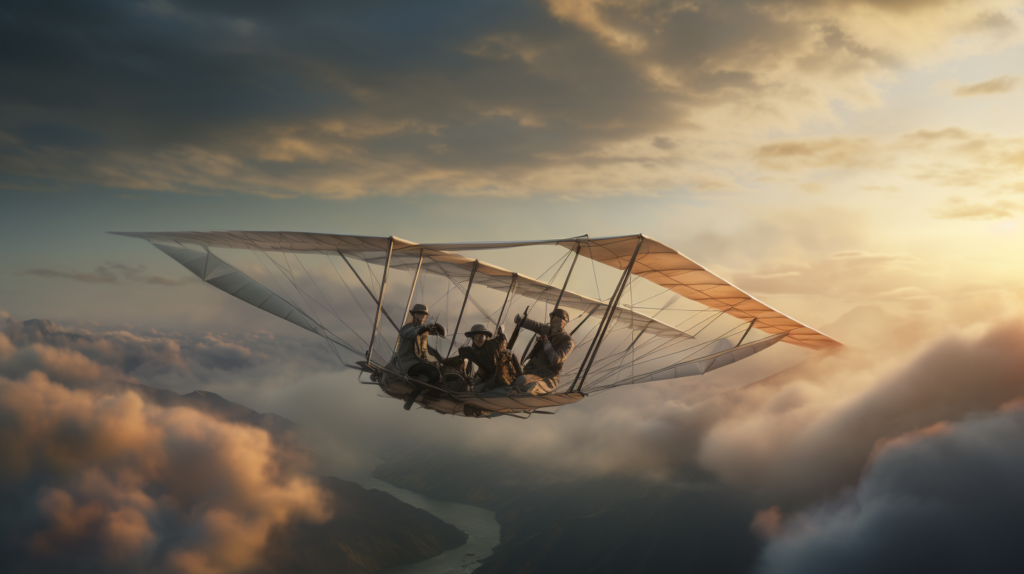
The Wright Brothers: Early 20th Century
The Wright Brothers, Orville and Wilbur, used gliders to test their theories of flight before achieving the first powered flight in 1903. Their gliding experiments at Kitty Hawk provided invaluable data that helped them understand the principles of lift, drag, and control.
Between the Wars: 1920s-1930s
The period between World War I and World War II saw significant advancements in glider design and construction. New materials like aluminum and advanced aerodynamic theories led to more efficient and capable gliders. This era also saw the rise of gliding as a sport, with the first gliding competitions being held.
World War II: Tactical Use
During World War II, gliders were used for tactical purposes, including the transportation of troops and equipment into battle zones. The silent approach of gliders made them ideal for covert operations, and they played a role in key missions like the D-Day landings.
Post-War Boom: 1950s Onwards
After the war, the focus shifted back to recreational and competitive gliding. Technological advancements continued to improve the performance of gliders, and the sport gained popularity worldwide. The 1950s and 1960s saw the establishment of various gliding clubs and organizations, further institutionalizing the sport.
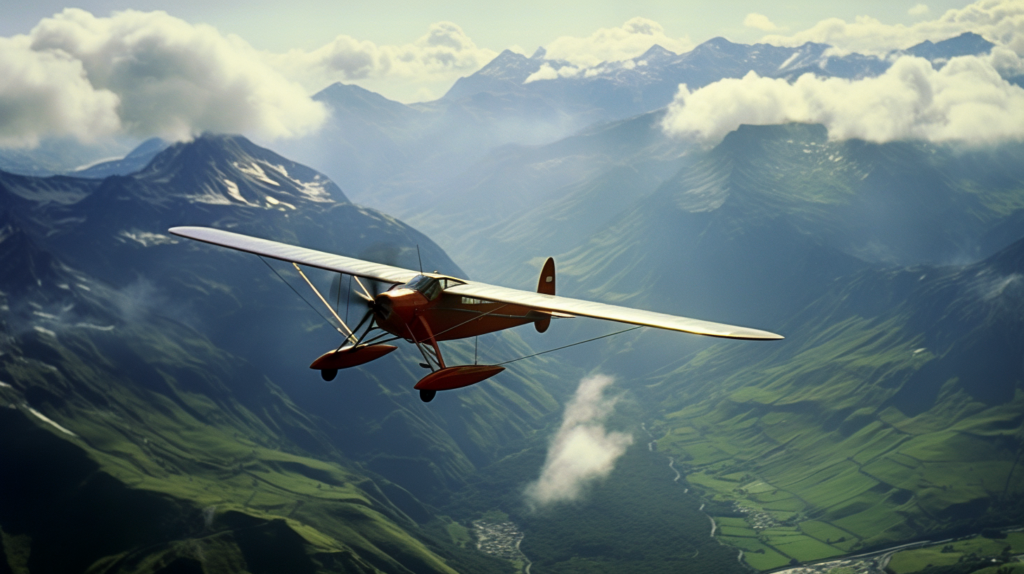
Modern Era: 21st Century
Today, gliding is a popular sport and recreational activity enjoyed by thousands of people around the world. Modern gliders are marvels of engineering, capable of long-distance flights and intricate aerobatic maneuvers. The sport has also diversified to include various forms of engineless flight, such as hang gliding and paragliding.
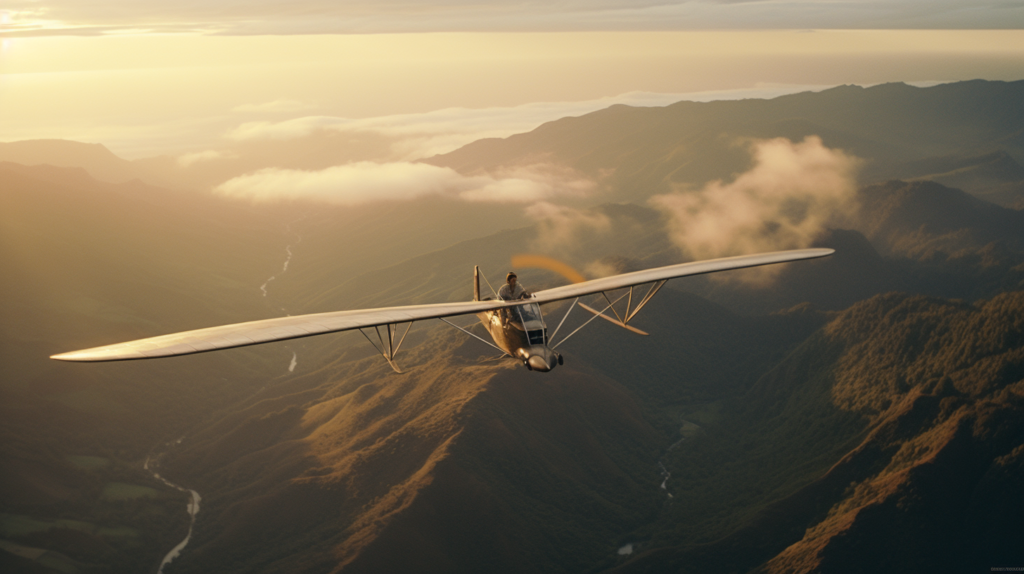
Milestones in Gliding History
- First Controlled Glider Flight: Otto Lilienthal, 1891
- First Gliding Competition: Wasserkuppe, Germany, 1920
- Introduction of Fiberglass Gliders: 1960s
- First Glider Flight Across the U.S.: Steve Fossett, 1983
- World Record for Longest Glider Flight: Klaus Ohlmann, 2006, over 1,500 miles
- Altitude Record: 2010, a team of glider pilots reached an altitude of over 50,000 feet
A Legacy of Innovation and Passion
The history of gliders is a testament to human ingenuity, curiosity, and the eternal desire to touch the sky. From the early experiments of aviation pioneers to the high-tech marvels of today, gliders have come a long way. Yet, the essence of gliding remains unchanged: it’s a celebration of flight in its purest form, a dance with the wind that continues to captivate the hearts and minds of those who dare to soar.

Becoming a Glider Pilot: Your Journey to the Skies
Requirements
- Training: Both ground school and flight training are necessary.
- Medical Exam: A health check is mandatory.
- Age and Experience: Certain age and experience levels are required.
The First Step: Ground School
Before you can take to the skies, you’ll need to hit the books. Ground school is the first step in your journey to becoming a glider pilot. Here, you’ll learn the fundamentals of aerodynamics, meteorology, navigation, and aviation law.
Topics Covered in Ground School
- Aerodynamics: Understanding lift, drag, and other forces acting on a glider.
- Meteorology: Learning to read weather conditions and their impact on gliding.
- Navigation: Basics of plotting courses and understanding airspaces.
- Aviation Law: Rules and regulations governing glider operations.
Hands-On Training: Flight School
Once you’ve got the theoretical knowledge, it’s time to apply it in the real world. Flight school involves a series of training flights where you’ll be accompanied by a certified instructor.
Key Skills Taught
- Takeoff and Landing: Mastering these crucial phases of flight.
- Soaring Techniques: Learning to find and use updrafts.
- Emergency Procedures: How to handle situations like stalls or unplanned landings.
Medical Requirements
Before you can fly solo, you’ll need to pass a medical exam to ensure you’re fit for the physical and mental demands of gliding.
Medical Checks
- Vision: Must meet certain standards, corrective lenses are usually allowed.
- Hearing: Important for communication and situational awareness.
- General Health: Checks for conditions that might impair your ability to fly safely.
Age and Experience Requirements
There are minimum age requirements for glider pilots, which vary by jurisdiction. In the United States, for example, you must be at least 14 to solo a glider and 16 to get a private pilot glider certificate.
The Final Hurdle: Certification
After completing your training and passing all required exams, you’ll be eligible for certification. This is your ticket to the skies, allowing you to fly gliders independently.
Types of Certifications
- Student Pilot Certificate: Allows for solo flights under supervision.
- Private Pilot Glider Certificate: For recreational flying.
- Commercial Pilot Glider Certificate: If you’re considering a career in gliding.
Continuing Education
Becoming a certified glider pilot is just the beginning. Many pilots continue to learn and improve, perhaps specializing in certain types of gliding like cross-country, aerobatics, or even becoming instructors themselves.
A Rewarding Journey
Becoming a glider pilot is a challenging but incredibly rewarding journey. It requires a combination of theoretical knowledge, practical skill, and a genuine passion for flight. But the payoff is immense: the freedom to soar through the skies, carried by the wind and your own skill, in one of the purest forms of aviation there is.
Safety Considerations: Navigating the Skies Responsibly
Key Points
- Weather: Avoid dangerous conditions like thunderstorms.
- Terrain: Skill in reading terrain and finding updrafts is crucial.
- Emergency Procedures: Know how to land safely without power.
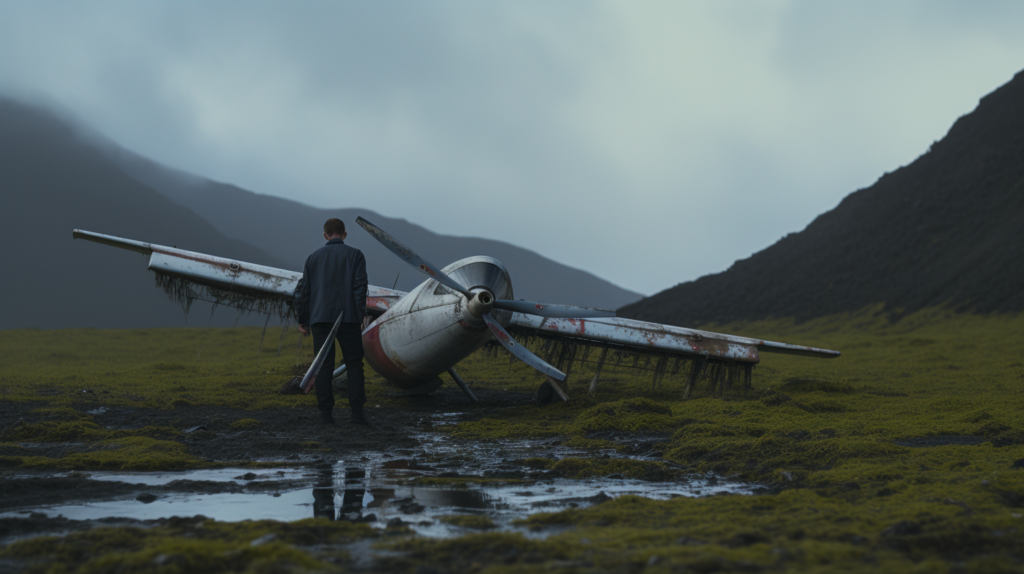
Weather Awareness: The First Line of Defense
One of the most critical aspects of gliding safely is understanding and respecting the weather. While gliders can take advantage of various meteorological phenomena for lift, certain conditions can be dangerous.
Dangerous Weather Conditions to Avoid
- Thunderstorms: These can produce severe turbulence and lightning, posing a significant risk.
- Strong Winds: Can make controlling the glider more challenging and may lead to dangerous situations.
- Low Visibility: Fog, rain, or haze can impair your ability to navigate and spot other aircraft.
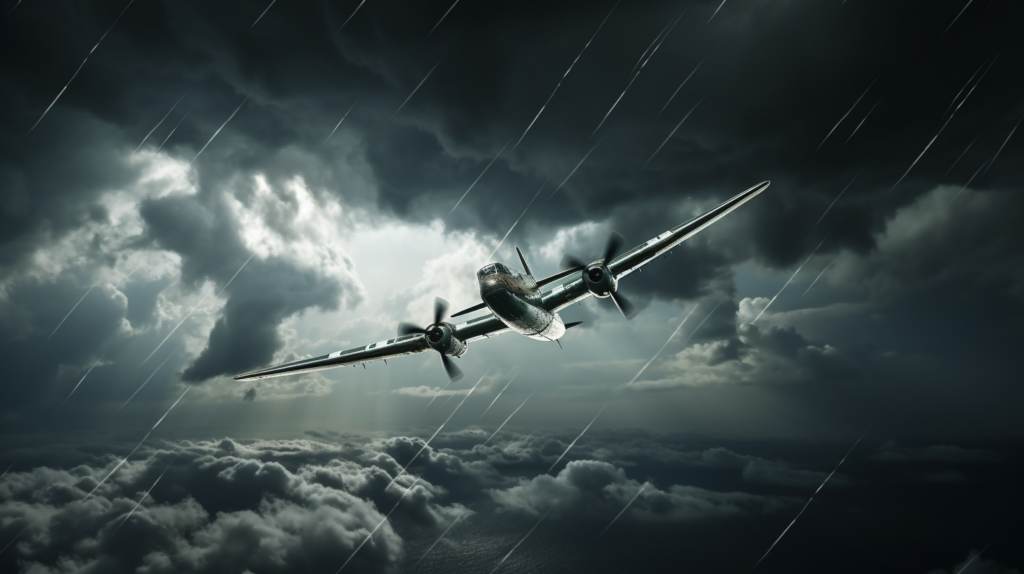
Terrain Reading: The Art of Finding Lift
Gliders rely on updrafts to gain altitude, and these updrafts are often generated by specific types of terrain. However, the terrain can also present hazards, especially in mountainous or forested areas.
Tips for Reading Terrain
- Mountain Ridges: Often generate updrafts but can also produce dangerous downdrafts on the leeward side.
- Open Fields: Good potential landing spots in case of emergency.
- Water Bodies: Can produce thermal updrafts but are generally to be avoided for emergency landings.
Emergency Procedures: Preparing for the Unexpected
Even with the best planning and most careful flying, emergencies can happen. Knowing how to respond can make the difference between a close call and a catastrophe.
Key Emergency Procedures
- Stall Recovery: Knowing how to regain control if your glider stalls.
- Unplanned Landing: How to choose a landing site and execute a landing without engine power.
- Parachute Use: Some gliders are equipped with parachutes for extreme emergencies.
Additional Safety Measures
- Pre-Flight Checks: Always inspect your glider thoroughly before taking off.
- Communication: Make sure your radio equipment is in working order for communication with air traffic control and other pilots.
- Flight Plan: Always file a flight plan and let someone know your intended route and expected time of return.
Safety is a Shared Responsibility
Safety in gliding is not just the responsibility of the individual pilot but is a shared concern among the entire gliding community. From instructors and flight schools to aviation authorities and fellow pilots, everyone has a role to play in ensuring that gliding remains a safe and enjoyable activity. By paying attention to weather, understanding the terrain, preparing for emergencies, and following best practices, you can enjoy the thrill of gliding while minimizing the risks.
Famous Glider Flights: Milestones in the Sky
Famous glider flights that are considered milestones in aviation history:

- 1804: George Cayley’s glider flight was the first design in history that included the principal features of the modern fixed-wing aircraft configuration1.
- 1896: Otto Lilienthal made the first sustained flight in a glider5.
- 1901: Alberto Santos-Dumont, a Brazilian aviator, made a flight in a glider that circled the Eiffel Tower5.
- 1921: William Hawley Bowlus made the first American soaring flight to exceed one hour duration2.
- 1983: Steve Fossett became the first person to fly a glider across the United States without stopping1.
- 2006: Klaus Ohlmann set a world record for the longest glider flight, covering more than 1,500 miles in a single flight1.
- 2010: A team of glider pilots set a new altitude record by flying to an altitude of more than 50,000 feet1.

These glider flights are significant because they pushed the boundaries of what was thought possible in gliding and paved the way for future advancements in aviation.
Notable Achievements
- Steve Fossett: First person to fly a glider across the United States.
- Klaus Ohlmann: Set the world record for the longest glider flight.
- Altitude Record: A team flew to an altitude of over 50,000 feet.
The Pinnacle of Gliding Achievements
The world of gliding has seen numerous milestones that have pushed the boundaries of what’s possible in unpowered flight. From cross-country journeys to altitude records, these famous flights have inspired pilots and enthusiasts alike. Here are some of the most notable achievements in the history of gliding.

Steve Fossett: The Transcontinental Journey
The Flight
In 1983, American adventurer Steve Fossett became the first person to fly a glider across the United States. The journey covered over 1,300 miles and took several days to complete, showcasing the capabilities of modern gliders and the skill required to undertake such a feat.
The Impact
Fossett’s flight was a watershed moment for gliding, proving that gliders could be used for long-distance travel and not just local soaring. It also brought significant media attention to the sport, inspiring a new generation of glider pilots.
Klaus Ohlmann: The Longest Glide
The Flight
German pilot Klaus Ohlmann set the world record for the longest glider flight in 2006. He covered more than 1,500 miles in a single flight, soaring over the Andes Mountains. The flight lasted for over 15 hours and reached speeds of up to 190 mph thanks to powerful mountain wave conditions.
The Impact
Ohlmann’s flight shattered previous records and showcased the incredible endurance and efficiency of modern gliders. It also highlighted the importance of understanding meteorological conditions, as Ohlmann expertly utilized mountain waves to sustain his flight.
Altitude Record: Soaring to the Stratosphere
The Flight
In 2010, a team of glider pilots set a new altitude record by flying to an altitude of over 50,000 feet. The flight took place in the Andes and used mountain wave conditions to reach these extreme heights.
The Impact
This record-breaking flight pushed the boundaries of what gliders could achieve in terms of altitude. It also had implications for scientific research, as flights at such high altitudes can provide valuable data on atmospheric conditions.
A Legacy of Excellence
These famous glider flights serve as milestones in the ongoing quest to explore the limits of engineless flight. They inspire pilots to aim higher, fly farther, and dream bigger. Each record represents not just a personal achievement but a collective advancement for the sport of gliding, proving that the sky is not the limit but the beginning of what’s possible.



